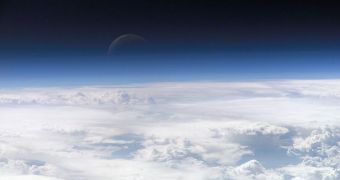One of the things that most people know about the atmosphere is that it contains the air which allows us and many other species to live. Some may know that the atmosphere is also a protective shield from cosmic radiation and solar winds, which would otherwise make Earth a very uncomfortable place to live. But the thin layer of gases surrounding our planet also has a number of other influences, and it's the goal of the “Global Geodetic Observing System (GGOS) Atmosphere” research project to figure out these complex and intricate relationships, AlphaGalileo reports.
According to previous studies, the atmosphere may modify many of Earth's traits, including its shape, its rotation and its gravitational field, but science has yet to form a comprehensive database of how this happens. This is precisely why the new cross-disciplinary study was set up. The work is being funded by The Austrian Science Fund (FWF), and one of its primary objectives is to support the development of the Global Geodetic Observing System (GGOS). All participants in this investigation aim at gaining a better understanding on how Earth's systems interact and influence each other.
In order to compile their models, the researchers will use only the best available data – of maximum spatial and temporal resolution – gathered by the European Center for Medium-Range Weather Forecasts (ECMWF). The GGOS Atmosphere project has three main areas of focus. The first is understanding how the pressure loading of the atmosphere affects the planet, while the second one refers to detailing the functions of its angular momentum. The third area of interest is discovering the coefficients of the atmosphere's gravitational potential, the team says.
“Only in this way will we be able to draw conclusions which are really relevant for society, like evidence for climate research or predictions for natural disasters,” says researcher Johannes Bohm, who is an expert at the Vienna University of Technology (TU). The GGOS is currently being investigated around the world, with numerous experts contributing considerably to its development. Over the years, they hope to obtain a thorough model of how Earth's interactions work, and how its various systems influence each other.
The Earth's pulse
Many different atmospheric influences have to be taken into consideration in modern geodesy, particularly when using space-geodetic techniques. The atmosphere delays radio signals from GPS satellites as well as signals from extragalactic radio sources, which are monitored using the VLBI (Very Long Baseline Interferometry) technique. Atmospheric loads (= air pressure), e.g. during a high pressure weather system, can change the shape of the elastic Earth by up to two centimetres and can also alter the Earth's gravitational force. Data from observations of the Earth's gravitational field — e.g. collected using special satellite missions — must, therefore, be adjusted to account for atmospheric influences. Atmospheric processes are also a significant cause of small, but measurable fluctuations in the Earth's rotation pattern, which can be seen from polar motion and changes in the length of day.

 14 DAY TRIAL //
14 DAY TRIAL //